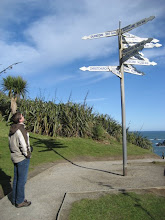Today I am intrigued by juxtaposition of contrasts in spoken (and written) Chinese:
- to ask, "Is it?" say shì bú shì (是不是), putting "is" next to "isn't";
- to refer to "thing," say dōng xi (东西), putting "east" next to "west";
- to ask, "How many?" say duō shao (多少), putting "many" next to "few"; and
- to refer to "size", say dà xiǎo(大小), putting "big" next to "small."
Though not in this blog's
goal list, "Chat in Mandarin" is my 2008 non-work mental challenge. I listen daily on my 30 GB iPod to
Instant Immersion Mandarin Chinese or
Pimsleur Chinese (Mandarin) I, usually while doing
30 minutes of moderate activity. I chose Mandarin because
Asia would be new to me and because there are
perhaps 1.05 billion speakers. It's the language with the most native speakers (followed by Spanish and English, which I already speak)--an order of magnitude more speakers than other Chinese languages like Cantonese.
I've written about mental
self-improvement several times. Recent research into
neuroplasticity suggests thinking, learning, and acting actually change the brain. One of the activities
Mozart's Brain and the Fighter Pilot: Unleashing Your Brain's Potential consequently encourages is memorization. Since Mandarin is not in the
Indo-European language family like Spanish and English, it poses a memorization challenge for me (though thankfully not due to noun declensions or verb conjugations).
An additional memorization challenge is learning Chinese characters or
hàn zì (汉字). In fact, some
recommend against learning characters at first; others think writing is the main reason
Chinese is so hard. (In contrast, to me the
four tones don't sound hard so far.) I am studying an average of one
simplified character and compound per day from
Tuttle Learning Chinese Characters Volume 1: A Revolutionary New Way To Learn And Remember The 800 Most Basic Chinese Characters.
For flashcards I enter
hàn zì into Zhongwen Development Tool (
zdt),a program discussed in
Chinese forums that has a plug-in to search the
CEDICT Chinese-English dictionary. I also downloaded a Pimsleur
word list for zdt. The zdt stores
hàn zì,
pīnyīn romanization, and English definition. Other information (e.g.,
Learning Chinese Characters visual imagery), I enter into
Mnemosyne.
Instant Immersion Mandarin Chinese came with
Talk Now! Plus software from Eurotalk Interactive. However, both of the
SourceForge programs (zdt and Mnemosyne), like the
Pimsleur language learning system, use spaced repetition techniques (an idea I first encountered in Tony Buzan's
Use Both Sides of Your Brain). Mnemosyne uses an early version of (and simpler interface to) the
SuperMemo algorithm
discussed in this month's
Wired.
This juxtaposition of modern research and tools with an ancient language and writing may help my memory, but it also provides direction for
travel. True immersion may be available in the People's Republic of China, where the official language is Standard Mandarin and the government uses simplified characters.
